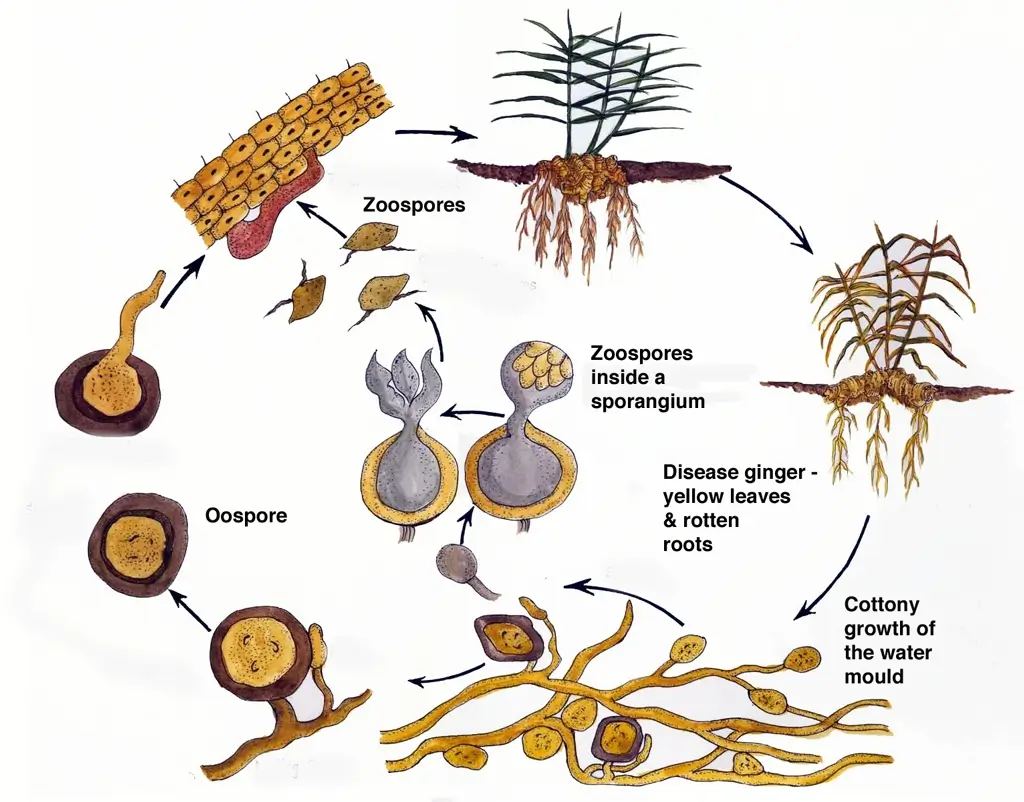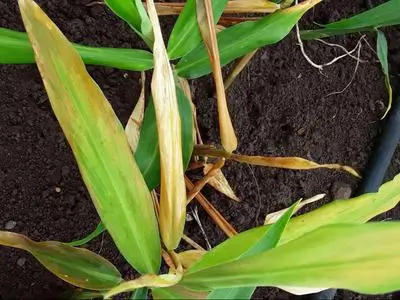The rainy season is now starting, which is beneficial for crops. However, Ginger farmers should be alert. Excess moisture is not good for ginger, as it can lead to rhizome rot or soft rot. The monsoon may not bring happiness if we don’t monitor ginger farms. It is important because Pythium and Fusarium species, which cause soft rot in ginger, are among the most significant pathogens affecting ginger. These pathogens can reduce ginger production by 50-90%.

But what causes rhizome rot in ginger? Does rhizome rot decrease the yield of ginger? What are the symptoms of soft rot in ginger? How can rhizome rot in ginger be controlled?
What Causes Rhizome Rot in Ginger?
Watering plants enough is good for them, but when it comes to ginger, watering might sometimes act as a villain.
Here’s why:
- Rhizome rot of ginger is caused by the soil-borne fungus Pythium aphanidermatum. The favourable condition for this fungus to multiply is increased soil moisture with the onset of the southwest monsoon.
- Choosing the planting material plays a major role. Make sure the rhizome is disease-free, as the fungus can survive in diseased rhizomes kept for seeds.
- It is caused by resting structures like Chlamydospores and Oospores that reach the soil from infected rhizomes.

- Younger sprouts are more prone to this disease, and the severity of the disease increases if there is nematode infestation.
If you are facing a nematode problem in your field, learn how to control nematodes here
- Not only high moisture content but also increased temperatures above 30°C are favourable conditions for disease incidence.
- Make sure the field is well-drained, as waterlogged conditions increase soft rot incidence.
Signs of Rhizome or Soft Rot in Ginger
Early signs of the infection are seen in the collar region. This later moves upwards and downwards.
- The collar region of the pseudostem shows water-soaked symptoms, and later, rotting spreads to the rhizome.
- Root infection can be observed in later stages.
- The leaf tips of lower leaves show light yellowing symptoms, which later spread to the leaf blades.

- The severity of the disease leads to withering, dropping, and drying of the pseudostem.

- The affected rhizomes become soft, water soaked, discoloured and often have a foul smell due to the rot.
3 Methods to Manage Rhizome Rot of Ginger
Rhizome rot, also known as soft rot of ginger, is a serious threat to ginger crops as it directly impacts the quality and yield of the crop. Additionally, the microorganisms causing soft rot can affect the host at any stage of crop development, including post-harvest storage of rhizomes. The damage during preservation can range from 24-50% and sometimes surpasses 90%.
Adopting management practices and closely monitoring the infestation is important because Pythium species persist in the soil when the temperature increases and the moisture level is close to or above saturation.
Physical Methods for Managing Soft Rot in Ginger
- Healthy Seedlings:
- Choose healthy, illness-free seedlings to reduce infection risk by Pythium spp.
- Methods: germ enrichment, seed disinfestation and germ sterilization.
- These methods treat pathogens without harming seed viability.
- Crop Rotation:
- Growing the same crop yearly can increase pathogen presence.
- Use crop rotation to prevent pathogen resurgence.
- Maize and paddy can be used as substitute crops after growing ginger.
- Inhibitory Soils:
- Soils with high clay content and low pH are better for ginger.
- Land Solarization:
- Heating soil covered with plastic using sunlight reduces microbes, parasites, and weeds.
- Effective for 1-2 months in the summer.
- Benefits: Promotes crop development and inhibits illnesses.
- Silicon Addition:
- Adding silicon to soil promotes plant growth and inhibits P. aphanidermatum.
- Phyto-Sanitation:
- Regularly practice phyto-sanitation when infection signs appear.
- Identify and destroy infected crops.
- Sanitise tools used for phyto-sanitation to prevent disease spread.
Chemical Methods to Control Soft Rot of Ginger
- Rhizome Treatment
- Before storing the seed rhizomes, soak them in a solution of 3 grams of Mancozeb 75 WP in a litre of water for 30 minutes.
- Sun-dry the treated rhizomes before storing them.
- At the time of planting, soak the treated rhizomes in a solution of 6 grams of Metalaxyl MZ 72 WP in a litre of water for 30 minutes, and then plant them in the field.
- Treating the rhizomes with 1% formaldehyde and planting the ginger under shade has a lower incidence rate (19.4%) compared to planting without shade (41.3%)
- Soil Drenching
- Soil drenching with Zineb, Copper oxychloride, Thiram and Mancozeb protects the ginger plant from soft rot
Biological Methods to Control Soft Rot of Ginger
- To biologically control rhizome rot in ginger, you can use fungal endophytes such as Trichoderma species.
- T. viride, T. hamatum, and T. harzianum, have an antagonistic response towards pathogens like Pythium aphanidermatum, Fusarium solani, and Fusarium equiseti. These biological control agents, when applied to soil along with substances like neem oil cakes, effectively control P. aphanidermatum, which causes soft rot of ginger.

How Trichoderma acts as an organic alternative to chemical pesticides. Learn here.
- Other biological control organisms like T. virens, T. harzianum, and T. aureoviride have also been reported to prevent ginger soft rot by reducing the colony abundance of F. solani and P. aphanidermatum.
Rhizome rot is a big problem for ginger plants, with the joy of welcoming the monsoon there is also fear of rhizome rot in the field. Early signs include soggy stems and yellow leaves. To fight it, you can choose healthy plants, use treatments and employ helpful fungi like Trichoderma. By doing these things, you can protect the crops and get better harvests. Staying watchful and using smart farming methods are important for keeping ginger safe from this disease.
If you want to avail of these pesticides, download AgriApp today and add these insecticides to your cart.
Don’t forget to apply our special coupon code RR150 for added savings. Happy shopping!